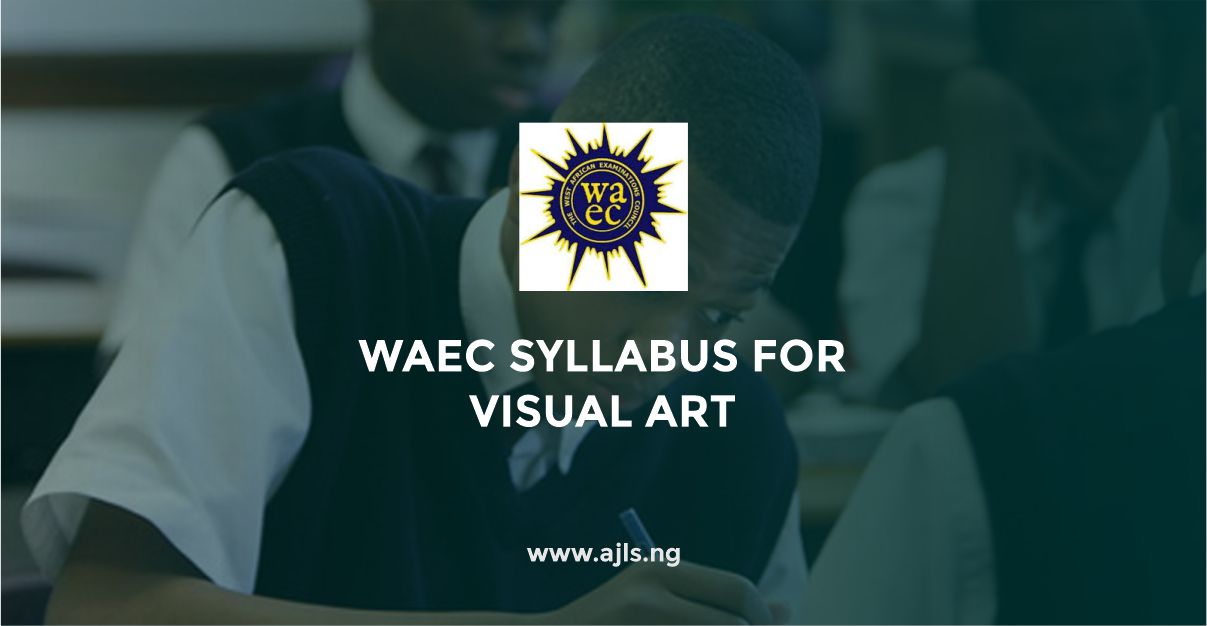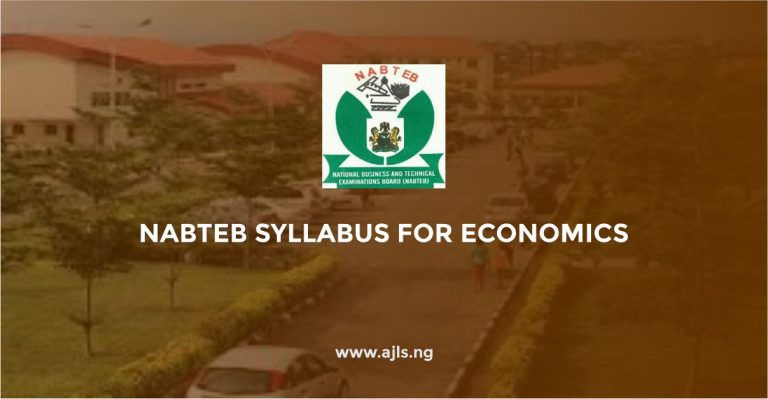WAEC Syllabus For Visual Arts 2025

Are you preparing for WAEC and have Visual Arts as one of your registered subjects? If so, we hope you are studying with the WAEC syllabus. If not, we strongly recommend getting the WAEC Syllabus for Visual Arts as soon as possible to ensure focused and effective preparation.
Below, we have provided a detailed syllabus along with a list of recommended books to support your studies. You can download the WAEC Syllabus for Visual Arts and start preparing properly for your examination.
The WAEC Visual Arts exam has three papers:-
- Paper 1: 40 multiple-choice questions (50 mins, 40 marks).
- Paper 2: Eight essay questions from three sections (General Art, West African Art, and Historical Art). Candidates answer four questions (2 hours, 60 marks).
- Paper 3: Practical exam with three sections:
- Section A: Drawing (3 hours, 100 marks).
- Section B: 2D Creative Design (graphic design, textiles, picture-making) (3 hours, 100 marks).
- Section C: 3D Creative Design (sculpture, ceramics, crafts) (completed in six months, 100 marks).
WAEC Syllabus For Visual Arts
| SN | TOPICS | OBJECTIVES |
|---|---|---|
| PAPER I & II | ||
| 1 | GENERAL KNOWLEDGE IN ART | i. Nature and branches of Art and careers in art. ii. Visual awareness, understanding, and appreciation of Art elements, their forms, characteristics, and functions e.g. line, colour, space, shape, form, texture, etc. iii. Principles of Art – creative application of art and design principles e.g. balance, rhythm, proportion, harmony, emphasis, variety, etc. Perspective – meaning and type e.g. aerial, linear (angular/parallel), and foreshortening. v. The knowledge of production, use, and care of art/craft tools and materials e.g. brushes, pencils, colour, palettes, easels, etc. vi. Art and craft terms e.g. tie and dye, biscuit ware, silhouette, relief, chiaroscuro, sfumato, aperture, etc. vii. The inter-relationships of the arts e.g. music, visual art, dance, drama and literary arts. |
| 2 | ART OF WEST AFRICA | i. Ancient Traditional Art – Cameroon – Bamileke – Dahomey (Benin Republic) – Fon – Gambia – Wollof, Mandinka, Jola – Ghana – Ashanti, Fante, Ewe, Frafra – Guinea – Kissi – Cote d’Ivoire – Senufo, Baule – Liberia – Dan and Ngere – Mali – Dogon, Bambara – Sierra Leone – Mende, Sherbro – Upper Volta (Burkina Faso) – Mossi, Bobo, Kurumba – Nigeria – Benin, Ife, Nok, Igbo-Ukwu ii. Modern Traditional Art – Oshogbo art, Ashanti and Ewe Kente, Modern Benin art, Winneba pottery, Abuja pottery, Ntoso adinkra, Bida brass works, calabash carving, Enyiresi basketry, Mbari mud sculpture, weaving, leatherwork, wall decoration, indigenous decorative motifs. iii. Contemporary Art – Art institutions, museums, and organizations (e.g., INSEA, NSIAD, SNA, NAAC, Ona Art Movement, etc.). – Cultural festivals and artistic significance (costumes, symbols, objects, masks, body decorations, etc.). – Outstanding contemporary West African artists: their training, style, achievements, and contributions. |
| 3 | PRE-HISTORIC, ANCIENT EGYPTIAN & WESTERN ART | i. Pre-historic Art (Earlyman’s Art 20,000 – 2000BC) – Paleolithic, Mesolithic, Neolithic stone Ages, beliefs, materials, characteristics, and functions. ii. Ancient Egyptian Art (11,000 – 7,000 BC) – Old, Middle, and New Kingdoms, beliefs, styles, and functions. iii. Greek Art – Periods and characteristics. iv. Medieval Art – Features, media, and characteristics. v. 19th Century Art – Impressionism (Paul Cezanne, Claude Monet, Edouard Manet, Georges Seurat) & Post Impressionism (Vincent van Gogh, Paul Gauguin). vi. Renaissance Art – Early, Low, and High Renaissance (Giotto, Donatello, Masaccio). vii. 20th Century Art – Cubism (African Art influence, Pablo Picasso, George Braque). |
| PAPER III: DRAWING | ||
| 4 | DRAWING | i. Drawing from Objects – Arranged group compositions of man-made objects (e.g., radio sets, car parts, bicycles, bottles). ii. Drawing from Nature – Study of natural objects like flowers, foliage, fruits, rocks, bones, insects, birds, fish, crustacean, shells. iii. Drawing from Life – Observing and depicting a posed human figure (male or female). |
| PART B: CREATIVE ART (2-DIMENSIONAL ART) | ||
| 5 | GRAPHICS DESIGN | i. Lettering and Poster Design – Formal lettering, pictorial posters, book covers, greeting cards, emblems, logos. ii. Book Illustration – Story and text illustrations for books, magazines, newspapers. iii. Printmaking – Linocut, woodcut, yarn print, stenciling, screen printing. iv. Package Design – Wrappers, cereal packages, CD jackets. v. Computer Graphics – Using CorelDraw, and Adobe Photoshop. |
| 6 | TEXTILE DESIGN | i. Fabric Design – Batik, tie-dye, block, or screen printing on cotton or silk. ii. Appliqué – Shaped fabric pieces sewn onto a foundation fabric. iii. Tapestry – Woven patterns or pictures for upholstery or wall hanging. |
| 7 | PICTURE MAKING | i. Painting – Illustrative compositions using various media, including murals. ii. Photography – Basic photography skills, portraits, landscapes, nature, pets, seascapes, experimental photography. iii. Mosaic – Picture-making using colored materials (glass, paper, tiles). iv. Collage – Synthesizing materials like cloth, paper pieces, and objects onto a surface. |
| PART C: CREATIVE DESIGN (3-DIMENSIONAL ART) | ||
| 8 | SCULPTURE | i. Rendering sculptures in clay, metal, wood, papier-mâché, cement. ii. All clay works must be fired. |
| 9 | PRODUCT DESIGN/MODELING | Designing and producing models of industrial products (automobiles, phones, bottles, cosmetics). |
| 10 | CERAMICS | i. Creating ceramic wares (jugs, vases, bowls, toys, figures). ii. Clay works must be fired. |
| 11 | CRAFTS | i. Basketry – Making mats, chairs, hats, stools, bags, macramé with cane, and raffia. ii. Jewelry – Designing ornaments with metals, beads, plastic, shells, and seeds. iii. Calabash Decoration – Decorating calabash using various techniques. |
Recommended Text Book For WAEC Physical Education 2025
- Amenuke, S. K., & Dogbe, B. K. et al. (n.d.). General knowledge in art for senior secondary schools. Ministry of Education.
- Ayisi, E. O. (1972). An introduction to the study of African culture. Heinemann.
- Beier, U. (1960). Art in Nigeria. Cambridge University Press.
- Banjoko, I. (n.d.). Cultural and creative arts.
- Clement, R. (n.d.). The art teacher’s handbook. Century Hutchinson Limited.
- De Samsmarez, M. (n.d.). Basic design: The dynamics of visual form. Studio Vista Limited.
- Filani, K. (2005). Patterns of culture in contemporary Yoruba art. Symphony Books.
- Gardner, H. (1980). Art through the ages. Harcourt, Brace & World.
- Gillon, W. (n.d.). A short history of African art. Penguin Books Limited.
- Gombrich, E. H. (n.d.). The story of art. Phaidon Press Limited.
- Harlow. (n.d.). Art history in Africa. Longman Group Limited.
- Mayers, B. S. (n.d.). Art & civilization. McGraw Hill.
- Ogunmor, E. (2007). Certificate art for junior and senior secondary schools. University Press.
- Olaosebikan, W. A. (n.d.). Cultural & creative arts: A sourcebook for teachers. Evans.
- Osborne, H. (n.d.). Art of appreciation. Oxford University.
- Oyelola, P. (1981). Nigerian crafts. Macmillan.
- Pluckrose, H. (n.d.). The book of crafts. Evans Brothers Limited.
- Stemberg, H. (n.d.). Composition. Grosset & Dunlop.
- Talabi, G. (n.d.). Art teaching in African schools. Heinemann Educational Books.
- Underwood, L. (1968). Bronzes of West Africa. Transatlantic Art.
- Uzoagba, I. N. (2008). Understanding art in general education. African First Publishers Ltd.
- Wangboje, S. J. (1982). A textbook on art for senior secondary school. Evans Brother (Nig.) Ltd.
- Whitfield. (n.d.). Beginning pen lettering (Book 3). Gina and Company Ltd.
- Willett, F. (1967). Ife and the history of West African sculpture. Thames and Hudson
- Willett, F. (n.d.). African art. Thames and Hudson.
Share this post with others who have yet to see the syllabus. If you have questions, you can ask them in the comments and we will respond shortly.





